

|
|
Study, work or travel in the UK. British
culture and life.
|
|
||
|
|
|
|
||
 |
||||
|
|
|
|
||
 |
||||
|
Life
/ Post
|
||||
|
Sending and receiving letters or parcels in the UK
|
||||
A post office is a shop providing a range of postal and financial services.
A sub post office provides more limited services. You can find your nearest
post office from: http://www.royalmail.com
(choose "Essentials" > "Find a Post Office branch", select
"Post Office branch", enter your postcode, and click on "Search").
As well as postal services, main post offices may be able to provide you with
packing materials, TV licence and other official application forms,and may offer
some banking services (for example: bill payment, foreign exchange, money transfer,
travel insurance).
The Royal Mail is the UK's main delivery service for smaller items (letters,
large letters and packets). You can find full details about the
Royal Mail's services at http://www.royalmail.com
 Royal Mail delivery van |
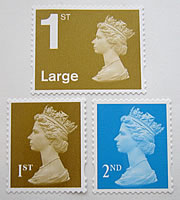 Stamps |
A parcel is a larger item (usually packed in a box) which is sent by post. Parcelforce is the main parcel delivery service. You can find full details at http://www.parcelforce.com, or ask at a post office for a brochure. A package sent abroad which contains only printed papers which weigh up to 5 kilograms can be sent at the cheaper letter postage rates, but any other package weighing over 2 kilograms will be considered to be a parcel. Use a strong box when you send a parcel. You can buy boxes from a post office, or you may be able to get used cardboard boxes free from a supermarket. Seal the top and bottom, using 3.8cm or 5cm wide plastic or re-inforced carbon sealing tape. If you send a suitcase instead, make sure that it is strapped well so that it cannot open accidentally while it is being transported. Use protective wrapping inside the parcel (for example, plastic bubble wrap or shredded paper) to prevent damage. You can buy packaging materials from post offices, stationery shops or from some newsagents. There are rules about the largest size of parcel which is allowed. To check your parcel, measure the longest side (its "length"), and the distance around the middle (its "girth"). Usually the maximum length is 1.5 meters, and the maximum sum of the length plus the girth of the parcel is 3 meters. Do not send anything that could be dangerous or which is not allowed (such as aerosol sprays, or batteries).
The cost of sending a letter or parcel depends on the size, the type of service
chosen (there are different levels of speed, security and insurance), the destination
(the world is divided into zones), and the weight (there may be a maximum weight
limit). If you know the correct postage and have attached enough stamps, you
can put your letter directly in your nearest postbox at any time. If you are
unsure about the cost of sending a letter or parcel, you should take it to your
post office and weigh it (otherwise it may be delayed, or the person receiving
it may have to pay extra). Write your address on the back, so that it can be
returned to you if it cannot be delivered.
A postcode (for example: CB12 3BT) identifies the exact location of
an address in the UK (similar to a "zip code" in the US). If you know
an address but you do not know its postcode, you can find it by going to: http://www.royalmail.com
and choosing "Postcode finder".
For more information about some of the uses of postcodes, see: Prepare/Arrival.
|
Weight
|
First class
|
Second class
|
|
0-100g
|
46p
|
36p
|
|
Weight
|
First class
|
Second class
|
|
0-100g
|
75p
|
58p
|
|
101-250g
|
£1.09
|
92p
|
|
251-500g
|
£1.46
|
£1.23
|
|
501-750g
|
£2.07
|
£1.76
|
|
Weight
|
First class
|
Second class
|
|
0-100g
|
£1.58
|
£0.92
|
|
101-250g
|
£1.96
|
£1.20
|
|
251-500g
|
£2.48
|
£1.52
|
|
501-750g
|
£3.05
|
£1.92
|
|
751-1000g
|
£3.71
|
£2.30
|
|
1001-1250g
|
£4.90
|
(none)
|
|
1251-1500g
|
£5.66
|
(none)
|
|
1501-1750g
|
£6.42
|
(none)
|
|
1751-2000g
|
£7.18
|
(none)
|
|
2001-4000g
|
£8.95
|
(none)
|
|
each extra 2kg (or part of this)
|
£3.05
|
(none)
|
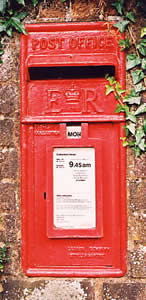 Rectangualr postbox |
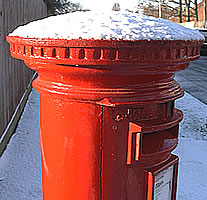 Round postbox |
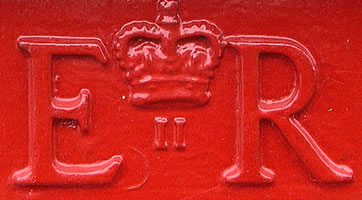 ER II: Queen Elizabeth the Second (1952-present) |

VR: Queen Victoria (1837-1901) |
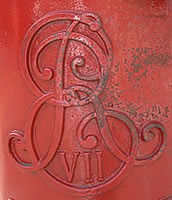 ER VII: Edward the Seventh (1901-1910) |
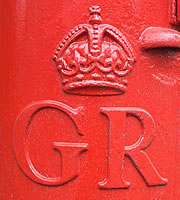 GR: George (the Fifth) (1910-1936) |
Sending a letter / large letter / packet to another country
There are two main ways to send a letter outside the UK (to any country except
England, Wales, Scotland or Northern Ireland). Airmail (post which is
transported by aeroplane) is more expensive than surface mail (post which
is transported by land or by sea). If you want the faster service, you should
write AIRMAIL in the top left hand corner (or attach an airmail sticker).
There are several types of letter which can be sent abroad more cheaply than
standard letters:
- Cheaper rates apply to aerogrammes (an air letter made from a single
folded sheet of paper) and postcards (a card sent without an envelope).
- A small packet is a package containing small items (such as a gift,
a tape or photographs) weighing up to 2 kilograms (Saudi Arabia: up to 1 kilogram),
You can include a short letter, invoice or other document which relates to the
contents of the packet, but not a personal letter (if you want to write one,
send it separately).
- Printed papers are printed items (such as books, magazines, newspapers
or photocopies) weighing up to 5 kilograms. You cannot include a personal letter,
but you can include a greeting card with up to 5 words written on it.
Small packets and printed papers are sent at a rate that is sometimes about
40% cheaper than the standard letter rate. The package must be easy to open
and inspect, so that a postal worker or customs officer can check the type of
contents. You can buy suitable envelopes from a post office, and should use
string rather than masking tape to seal it. In a post office, state which type
of package it is and whether you wish to send it by airmail or by surface mail,
and weigh it. Write SMALL PACKET or PRINTED PAPERS in the top left hand corner,
and write AIRMAIL (or attach an airmail sticker) if you are sending it this
way. Attach the stamps in the top right hand corner. If you are sending the
package outside the European Union, you will also have to attach a customs
declaration, describing the contents and their approximate value.
To find the cost of sending a letter abroad from the UK, see: http://www.royalmail.com.
Sending a parcel to an address in the UK
One of the cheapest ways of sending a parcel within the UK is to use the Parcelforce
Standard service.
Any parcel weighing over 10 kilograms costs the same (about 10 pounds); the
maximum weight is 20 kilograms.
The parcel should arrive at its UK destination after about 3 working days.
To find the price of sending a parcel within the UK, go to: http://www.parcelforce.com, choose"Postal calculator", and select "I'm sending a parcel within the UK". Enter the first part of your postcode and of the destination postcode (if you are sending a parcel within zone 1, which covers the whole of England and Wales and the Scottish lowlands, you can simply enter "E2" for both) and click on the Go button. Select a service (for example, Parcelforce Standard). Enter the weight of the parcel (in kilograms) and click on the Go button. The price should appear.
If you are sending a parcel outside the European Union, you may have to attach
a customs label, describing the contents and their approximate value.
Back to top
Sending a parcel to an address outside the UK
You can use Parcelforce's International Economy service to send things
abroad which you will not need soon. If you need to receive the parcel more
quickly, use the International Standard service. The maximum weight for
these services depends on the country; for most countries the limit is 20 or
30 kilograms. To find the price of sending a parcel outside the UK, go to: http://www.parcelforce.com,
choose "Postal calculator", and select "I'm sending a parcel
overseas". Select the destination country. Select a service (for example,
Economy or Standard). Enter the weight of the parcel (in kilograms) and click
on the Go button. The price should appear. Click on the Info tag and the Country
Info button to find out more details about services to this country, including
the expected number of days before the parcel is delivered. If you cannot easily
carry your parcel to the post office, you can arrange for Parcelforce to collect
your parcel from you (there is an extra charge for this).
A customs declaration label needs to be attached to most parcels which
are sent outside the European Union, and can be obtained from any post office.
It describes what is in the parcel and its value. Note that the value of used
clothes or other items is much less than their value when they are new. An import
tax (duty) may have to be paid by the person who receives the parcel,
depending on the rules in your country. Some (if in doubt, ask your country's
embassy in the UK; contact details can be found by selecting Links at the top
of the page and then choosing your country).
As an alternative to Parcelforce, you may want to use a shipping agent
or international freight company. You can send your things by ship (this
is cheapest, but may take about 2 months) by air (this may take about 2 weeks)
or by road (within Europe). Usually, a shipping agent will deliver cartons (boxes
of a standard size) and packing material to you. You fill the cartons and arrange
for the company to come back and pick these up. Pack carefully, and make sure
that you have insurance which will pay you if your things are lost or damaged.
Always ask for identification before letting someone into your accommodation.
If the company is a member of BAR Overseas (BAR is the British Association of
Removers), then if the company goes bankrupt you should receive back the money
you have paid to the company and the shipping order will be completed by another
company.
- You can find a removal company using UpMyStreet: http://www.upmystreet.com.
Select Find My Nearest … , enter a postcode or town name, and choose
the category Removals - Overseas.
- Alternatively, you can use Electronic Yellow Pages at http://www.yell.com
(look for "overseas removals" or "shipping & forwarding agents").
- You may also find advertisements from shipping companies at your school or
in newsletters.
To choose a reliable company, you may want to ask your student adviser or friends
about past experiences.
Back to top
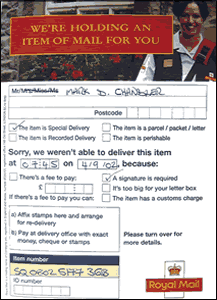 Missed letter delivery |
|
If customs officers in the UK believe that you may be importing new goods
into the UK (for example: because the value on the customs declaration form
is high or because the description does not make it clear that the goods are
not new), you may be asked to pay import tax. You have to pay this by cash or
cheque, not by debit or credit card. Do not argue with the postal worker, because
the decision about the tax is not made by the postal service. If you think that
the decision is unfair you will have to telephone the customs office (HM Customs)
and try to obtain a refund of your money. If they agree to give you a refund,
you will receive a UK cheque several weeks later.
Note that if you are going to fly back to your country from the UK, it may
be sensible to send some of your luggage by post. As well as making travelling
easier, it may save you money if the weight of your luggage exceeds the baggage
allowance (check your ticket for the limit on your flight). Excess baggage
charges by airlines can be expensive, although they are not always charged if
you are only slightly over the allowance. If the plane is full your excess luggage
may have to be sent separately as unaccompanied baggage. Excess baggage
companies at major airports (for example: http://www.excess-baggage.com)
may offer cheaper rates than the airlines for larger items, but their minimum
charges can make them more expensive for smaller excess weights.
One of the cheapest way to reduce the weight of the luggage which you carry
with you is to send books separately as printed papers (in separate packages
each weighing up to 5 kilograms), as long as you are happy to send them by surface
mail.
If you have other heavy or large items which take you above your baggage limit
(for example, televisions), it may be cheaper to sell them before you leave
the UK and then buy the same things again once you have returned to your home
country. For ideas about how to sell your things, see: Prepare/Return.
Preparing to return to your home country: Prepare/Return
Communication by computer (e-mail, Messenger): Life/Computer
Home page: Home
Back to top
© UK Student Life 2002-2012
|
|
|